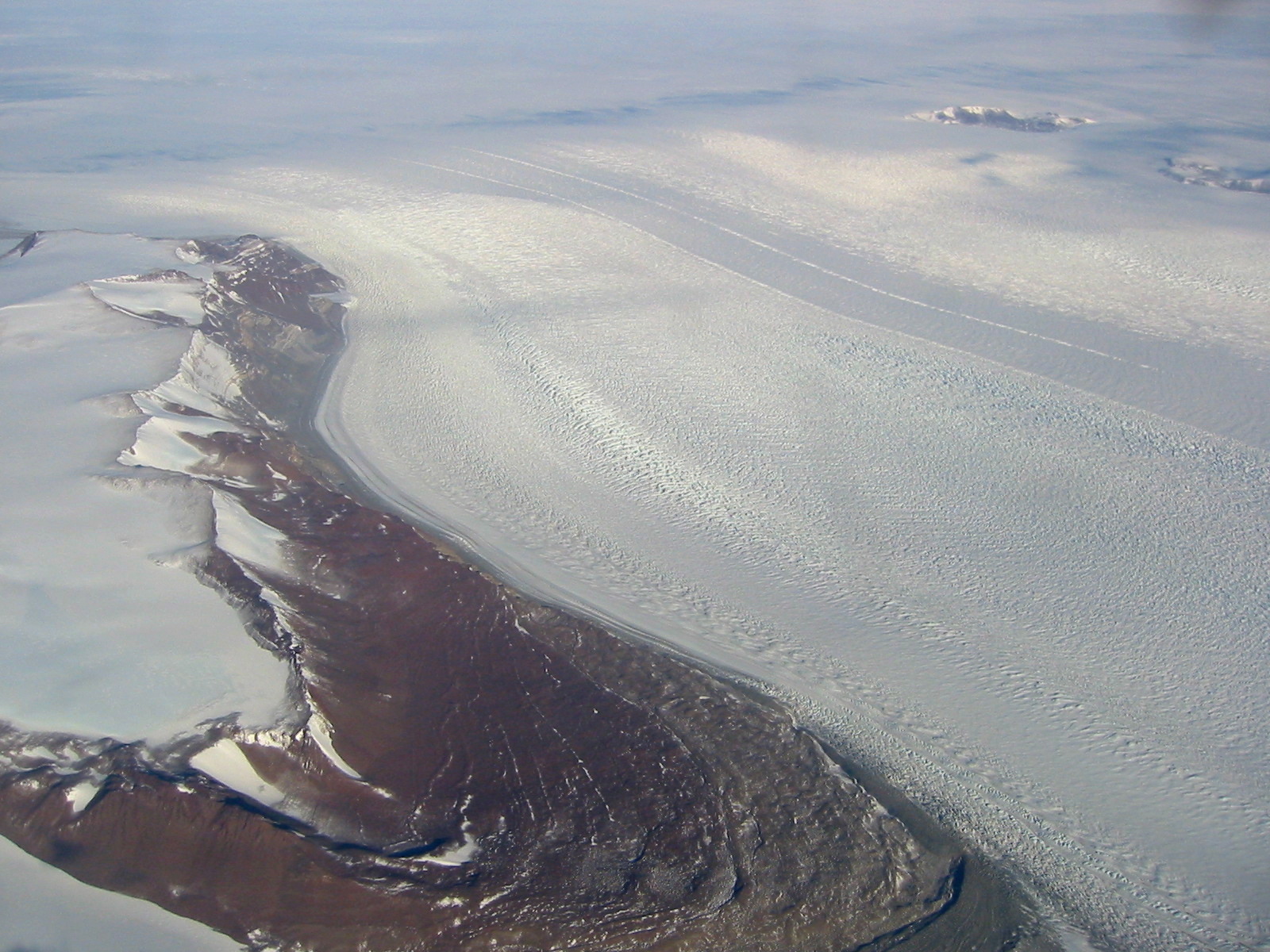Ice Sheet Assessments |
 |
Extensive Surface Melt on the Greenland Ice Sheet in 2012
Michael Key
University of Wisconsin-La Crosse
[10 June 2013]
A host of extreme and unusual events across the Greenland ice sheet (GIS) marked 2012 as a year of unprecedented climate change in the Arctic. Increased warming early in the season, unparalleled surface melt in July, record surface mass balance (SMB) loss, and record-length melt duration were the most notable of these events. The significance of each event can be appraised individually, but their significance as a whole may be greater than the sum of each part.
Early 2012 saw above-average melt extent in mid-May, with this trend continuing through June. By mid-July, melt had accelerated and extent was almost four times the average of 25% of the sheet, topping out at ~97%. Melt extent remained extraordinarily high through mid-September, the conclusion of the melt season.

Figure: Surface melt over Greenland’s ice sheet on July 8 (left) and July 12 (right). On July 8 about 40 percent of the ice sheet had undergone thawing at or near the surface. On July 12, an estimated 97 percent of the ice sheet surface had thawed. Light pink: probable melt (at least one satellite detected surface melting); dark pink: melt (two or three satellites detected surface melting).Satellites/sensors are MODIS, SSMI/S, and radar on Oceansat-2. Credit: Nicolo E. DiGirolamo, SSAI/NASA GSFC, and Jesse Allen, NASA Earth Observatory; http://www.nasa.gov/topics/earth/features/greenland-melt.html.
The high-reaching extent of the melt is also significant. While normally limited to costal regions and areas situated well-below 2,000 m above sea level (a.s.l.), melt was observed on dry snow facies at over 3,000m a.s.l. at Summit, starting on 11 July 2012 and lasting a couple of days. Prior to this event, the last melt event at Summit occurred in 1889, with on-site ice core records suggesting this type of extreme melt event occurs, on average, every 150 years.
A second, less sustained melt event was observed on 29 July 2012 when a scatterometer detected surface air temperature at Summit greater than 0˚C for approximately one minute. A continuation of these types of events would indicate an exasperated warming trend. Models already predict with 95% confidence that the dry snow facies of the GIS will “inevitably transition into percolation facies and experience routine melting on an annual basis” (McGrath et al., 2013).
The location of the 0˚C isotherm (IE) can also be observed in this warming trend. Over the 18-year period of 1995-2012, the 0˚C IE in West Greenland migrated upwards at a rate of 35 m/a. Similarly, the equilibrium line altitude (ELA) in West Greenland has migrated upwards over a 15-year period at a rate of 44 m/a. During the latter time period, the width of the ablation zone on GIS more than doubled.
Average SMB for 2012 was also significant when compared to previous averages. While values were near-average for the first ~200 days of the year, mid-July through September saw intense mass loss equal to a global sea level rise of 1.4 mm, or 500 km3. These values are over double the 2003-2012 averaged values of 0.65 mm and 234 km3 for the GIS.
Different areas of the GIS experienced differing degrees of melt throughout the year. In particular, parts of the northwest coast of Greenland experienced winter temperature increases of up to 10˚C since 1991. The total number of melt days for the northwest region in 2012 was also far above average. When compared to the average number of annual melt days for 1980-2010, the 2012 period saw over 45 additional melt days in the northwest, with some areas between 1,400 m and 2,000 m a.s.l experiencing an additional 60+ days of melt over the average. Parts of southern Greenland and areas of lower elevation saw less extreme conditions, with around 30 additional days of melting for the year. The total number of melt days was greater than the previous record from 2010, lasting up to 140 days in some areas.

Figure: Surface melt extent on the Greenland Ice Sheet detected by the SSM/I passive microwave sensor. Figure is from the Arctic Report Card Update for 2012, and after Tedesco et al. (2007).
Sources
- McGrath, D., W. Colgan, N. Bayou, A. Muto, and K. Steffen, 2013, Recent warming at Summit, Greenland: Global Context and Implications, Geophys. Res. Lett., doi:10.1002/grl.50456.
- Tedesco, M. 2007. Snowmelt detection over the Greenland ice sheet from SSM/I brightness temperature daily variations. Geophys. Res. Lett., 34, L02504, doi:10.1029/2006GL028466.
- NOAA Arctic Report Card for 2012: Greenland ice sheet
- Meltfactor.org (Jason Box)
- NSIDC GIS 2012 review
- Polar portal
- Laboratoire de Climatologie et Topoclimatologie, Université de Liège



